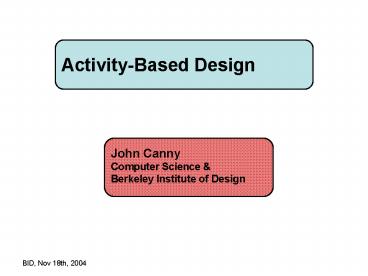ActivityBased Design - PowerPoint PPT Presentation
1 / 12
Title:
ActivityBased Design
Description:
Environment (surroundings) Context: immediate and implied. Improvisation, situated action ... We are guided by a pragmatic interpretation of 'activity theory' ... – PowerPoint PPT presentation
Number of Views:65
Avg rating:3.0/5.0
Title: ActivityBased Design
1
Activity-Based Design
John Canny Computer Science Berkeley Institute
of Design
2
Activity-Based Design
- IT designers normally think about
- User needs, goals, tasks, actions (e.g. design a
ticket machine for BART) - The users intent is clear, and success is
well-defined
3
Activity-Based Design
- Design for everyday life on the other hand
involves - User desires, motives
- Environment (surroundings)
- Context immediate and implied
- Improvisation, situated action
4
Activity
- Some examples of activity
- A knowledge-work project
- Eating-at-home
- Enjoying-Media (TV, Video, Audio)
- Learning a skill/language
- Getting a job
- Dating
- Personal Wellness
5
Activity
- We are guided by a pragmatic interpretation of
activity theory from Russian psychology. - Human behavior is viewed as an ongoing process
with a stable structure involving people, a
motive or object and the tools (often
information objects) that they use. - Activities are threadsthat span time and space
6
Activity maps (with X. Jiang)
Dating activity
People
Self
Date
Prospect
Mutual friend
Information objects
Movie info
Restaurant guides
Tools
Car
Cell phone
GPS gadget
Places
Home
Restaurant/Cafe
Venue
Times
Evening/weekend
Daytime
7
Using activity maps
- The activity map is a pattern, and makes use of
patterns to define its elements (people, tools
etc.) - We use a method called technology probes to
involve users in the design process. - A technology probe is an app that is given to
users early in the process, that encourages
adoption and experimentation.
8
Technology probes
- To simplify use of the technology probe, we use a
method called factoring functionality. - e.g. for location-aware services, we factor
complex apps into a few nouns and verbs - Nouns people and places
- Verbs read, write, listen-to, stream-to,
search-for - Most existing location-aware apps can be built on
these primitives, and we hope new ones will be
discovered.
9
Technologies
- Native XML-server hosts map data and user data.
Allows fast implementation of new designs (as
queries rather than code), arbitrary data types. - GPS-enabled smart phones (Motorola i830 with
Java) run a vector-graphics browser to support
server generated apps (no client code).
10
Automation modeling activities(w/ T. Rattenbury)
- We are also developing models to infer activities
as patterns in user log data. - The model we developed is GAP (GAmma-Poisson)
- X is an activity, Y is a hidden affinity for
some items, and F is use of those items (e.g.
email to someone, going to a place).
11
GAP and discrete data
- GAP was developed to model user activities from
desktop and mobile log data. - We have developed a logger for windows which
tracks your email, file use and web access. - Because of deep connections between activity and
texts, GAP also works very well as a document
model. It is the most accurate B.O.W.
probabilistic model on standard (TREC) data
Canny SIGIR 04.
12
Summary
- The Activity Perspective underpins several of our
projects. - It provides a good structure for human-centered
design which is not driven by particular
technologies or the constraints of a particular
environment. - At the same time, it provides a research
trajectory which can leverage contextual
information, to make systems more context-aware.































